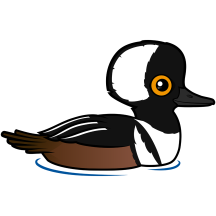Hooded Merganser
About the Hooded Merganser


The Hooded Merganser is a small bird in the duck family. They are named for the large head crest that can be expanded or contracted. In males the crest has a large white patch which makes these birds relatively easy to ID in the field. Females also have a head crest, but it is reddish; overall the females are duller than male Hooded Mergansers.
Hooded Mergansers nest in tree holes and during breeding season are found mostly in wooded freshwater ponds.
They range over much of North America, with year-round populations in both the southeast of the United States and the southwest of Canada. Migratory populations summer in the south of the U.S. and along much of the west coast.
Hooded Mergansers are diving ducks that feed on small fish, crustaceans and aquatic insects underwater.

Details & Statistics
International Names


































